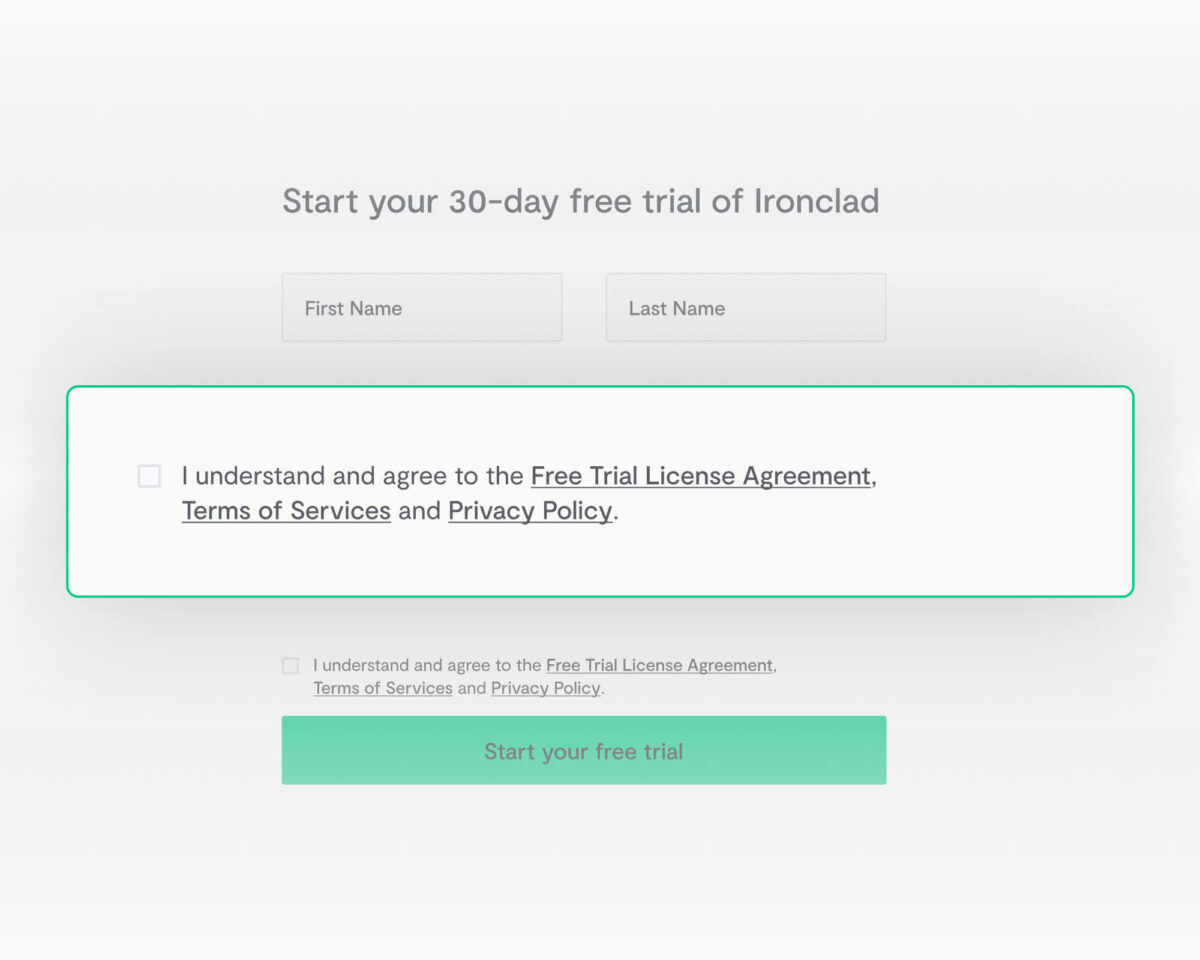Similar to non-disclosure agreements (NDAs), privacy disclosure agreements are typically used to protect a company’s operations, trade secrets, and intellectual property. They contain detailed clauses that prevent employees, partners, advisors, and other stakeholders from sharing, disclosing, and using confidential information.
Depending on your needs, you can choose from three types of privacy disclosure agreements: unilateral, bilateral, and multilateral. Read on to learn about the different types of privacy disclosure agreements and how you can draft and manage them more efficiently.
What is a privacy disclosure agreement?
A privacy disclosure agreement lets you limit how another party can share or use your company’s private information. This information can be anything you want to keep secret, including trade secrets, operational details, personal information, designs, business plans, logos, and unpatented inventions.
You will encounter privacy disclosure agreements whenever companies and individuals want to protect their confidential information from third parties and stakeholders. For instance, a marketing firm will use a privacy disclosure agreement when raising money from investors.
By requiring the investors to sign before privacy disclosure agreements, the firm can prevent investors from stealing, revealing, and using its operational processes and ideas. Without this agreement, the firm won’t be able to prove that the investors had misused their private information.
You will also see privacy disclosure agreements if you work in an industry that requires you to follow certain privacy laws. For example, let’s say you run a nursing home. Because nursing homes are considered covered entities under the federal Health Insurance Portability and Accountability Act (HIPAA), you must comply with HIPAA’s stringent privacy requirements, which require you to collect, use, and disclose clients’ personal health information (PHI) in certain ways. Privacy disclosure agreements will help you fulfill these obligations when working with third parties who will be exposed to your clients’ PHI.
Different types of privacy disclosure agreements
There are three types of privacy disclosure agreements: unilateral, bilateral, and multilateral.
Unilateral privacy disclosure agreements
Also known as unilateral NDAs, these privacy disclosure agreements only require one party to disclose private information to the other party. As the most common type of NDA, you will come across these contracts whenever individuals or companies need to disclose confidential information to clients, advisors, employees, and other stakeholders.
These agreements are typically made between:
- Companies and contractors
- Sellers and buyers
- Employers and employees
- Inventors and evaluators
Bilateral privacy disclosure agreements
Bilateral privacy disclosure agreements—also known as two-way NDAs and mutual NDAs—require both parties to reveal private information to each other. Both parties can limit how the other party will share, use, and disseminate their information.
These agreements are used during corporate takeovers, mergers and acquisitions, and joint ventures—basically, whenever parties need to exchange a large amount of confidential information during negotiations.
Multilateral privacy disclosure agreements
A multilateral or multiparty privacy disclosure agreement involves three or more parties. At least one of these parties will disclose information to the others and limit the others from using, sharing, and using that information.
Multilateral privacy disclosure agreements can help simplify the negotiation and contract management process because they eliminate the need for separate unilateral or bilateral agreements between two parties.
For instance, you can use a single multilateral privacy disclosure agreement for parties A, B, and C instead of entering into three separate bilateral agreements between A and C, A and B, and B and C.
How to create a privacy disclosure agreement
Whether you’re writing a unilateral, bilateral, or multilateral privacy disclosure agreement, you need to include the following:
The parties’ information
Like all agreements, your privacy disclosure agreement needs to identify the parties to the contract. Use individuals’ and companies’ full legal names as they appear on their official IDs (i.e., an individual’s driver’s license or passport and a company’s Articles of Incorporation). You also need to establish who is the recipient and who is the owner.
Confidential information
Define “confidential information” as clearly as possible. Identify categories of information you want to keep private—like unpatented inventions and business processes—as well as specific pieces of data, if applicable.
Other party’s treatment of confidential information
Detail how the recipient(s) will treat the confidential information and explain how they should handle hard and electronic copies of the information.
To prevent your information from getting into the wrong hands, you should include the following language:
- The recipient can only give your information to pre-approved individuals in their own company (i.e., marketing executives who need the confidential information to determine how the deal will progress).
- The recipient can only use the information for purposes approved by the owner (i.e., the recipient is only allowed to use the information to determine how the deal should progress because that’s why the owner disclosed the information in the first place).
No license
Explain that the owner is not giving a license to the recipient to use the confidential information. As a result, the recipient does not own any of the information.
No assignment
Limit the recipient from transferring their duties and obligations to a third party.
Here’s an example of a no assignment clause:
This Agreement and all obligations and rights of the Recipient are personal to the Recipient and may not be assigned or transferred by the Recipient at any time without prior written consent of all parties.
Exceptions
List out situations where a recipient’s disclosure of private information would not go against the privacy disclosure agreement. Common examples include:
- If the information reaches the public through no fault of the recipient
- If the public or a third party can get the same information through a different method that’s not part of the privacy disclosure agreement
- If the owner of the private information explicitly consents to disclose the information to the public or a third party
Protective measures
Disclosing parties may want to add additional protective measures to prevent improper use or sharing of the information, such as:
- Specifications and restrictions for destroying private information
- Limits on copying and transmitting the information electronically and in hard copy
- Requirements for keeping the information in a specific location
- Security protocols for data and cloud systems where the information will be stored
- Notifications of unauthorized disclosure and use
Term
Talk about how long the recipient will keep the confidential information private. You can bind parties to secrecy for a set amount of time—i.e., 20 years—or for an indefinite period of time, which means the recipient will never be able to share your information with anyone.
No publicity
Show how the owner and recipient will keep their relationship secret. This clause is especially important for joint ventures and mergers and acquisitions, as the value of the companies can drop if the public knows about their relationship.
Penalties
Explain the penalties that the recipient will face for violating the privacy disclosure agreement. Penalties can be as strict or as lax as you want. Some privacy disclosure agreements require recipients to pay damages for lost profits and opportunities, while others impose criminal charges.
All the rest
Like other contracts, you also need to include clauses for notices, termination, and jurisdiction.
Writing and managing privacy disclosure agreements
Privacy disclosure agreements can be quite complex, making them a challenge to both write and manage. And it’s particularly hard if you’re still storing contracts in hard-to-reach places like USBs, hard drives, and cabinet drawers.
That’s where Ironclad comes in. Sleek, versatile, and user-friendly, Ironclad is an enterprise-level contract management software that turns contracts from barriers to enablers.
Our Data Repository allows you to store privacy disclosure agreements from all over your company in a centralized, searchable hub, allowing you to locate contracts and find answers to questions within seconds. You can also give other users as little or as much access to your privacy disclosure agreements as needed. This can help you increase collaboration between departments and break down your organization’s contract silos.
Ironclad also has a Workflow Designer that enables you to draft and approve automated workflows for privacy disclosure agreements. Codeless and easy to implement, Workflow Designer has a simple drag-and-drop user interface that anyone can use to build and launch privacy disclosure agreement generation and approval processes. They just have to:
- Upload a privacy disclosure agreement template
- Tag fields that need to be filled
- Add signers and approvers.
Keep your information protected
A privacy disclosure agreement is a legally binding document that you can use to protect confidential information when working with others. Also known as NDAs, privacy disclosure agreements can be used to protect any information you want, including trade secrets, business plans, and unpatented inventions.
Although they seem straightforward, privacy disclosure agreements can be difficult to draft and manage, since they contain so much information. That’s why you should consider using Ironclad. A top-notch contract lifecycle management (CLM) software, Ironclad has all the tools you need to create, manage, and execute privacy disclosure agreements.
Ironclad is not a law firm, and this post does not constitute or contain legal advice. To evaluate the accuracy, sufficiency, or reliability of the ideas and guidance reflected here, or the applicability of these materials to your business, you should consult with a licensed attorney. Use of and access to any of the resources contained within Ironclad’s site do not create an attorney-client relationship between the user and Ironclad.
- What is a privacy disclosure agreement?
- Different types of privacy disclosure agreements
- How to create a privacy disclosure agreement
- Writing and managing privacy disclosure agreements
- Keep your information protected
Want more content like this? Sign up for our monthly newsletter.



